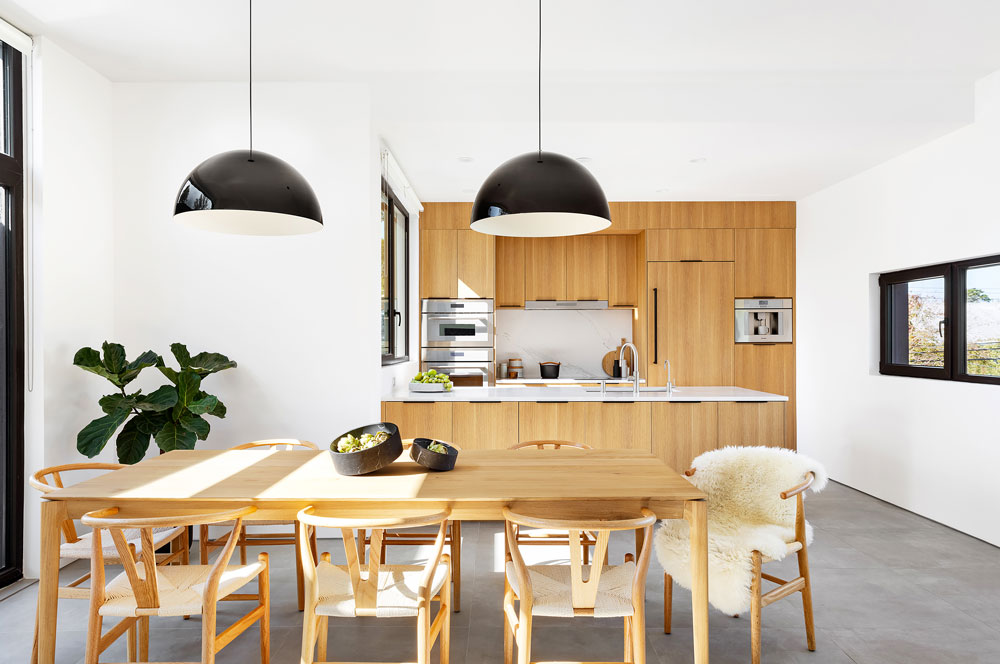Eco-Friendly Elevation
Writer Meg Fox | Photographer Donna Dotan-DDReps | Designer Joseph Hom | Architect Ryall Sheridan Architects | Builder Cross Builders LLC | Location Long Branch, NJA Jersey Shore home rises to meet high-performance building standards in compact, gracious style
A tiny lot in Long Branch — situated along a stretch of garden apartments, town houses and multifamily homes — sat vacant for years, its potential unrealized until Joe Hom and Daniel Hanan set their sights on it.
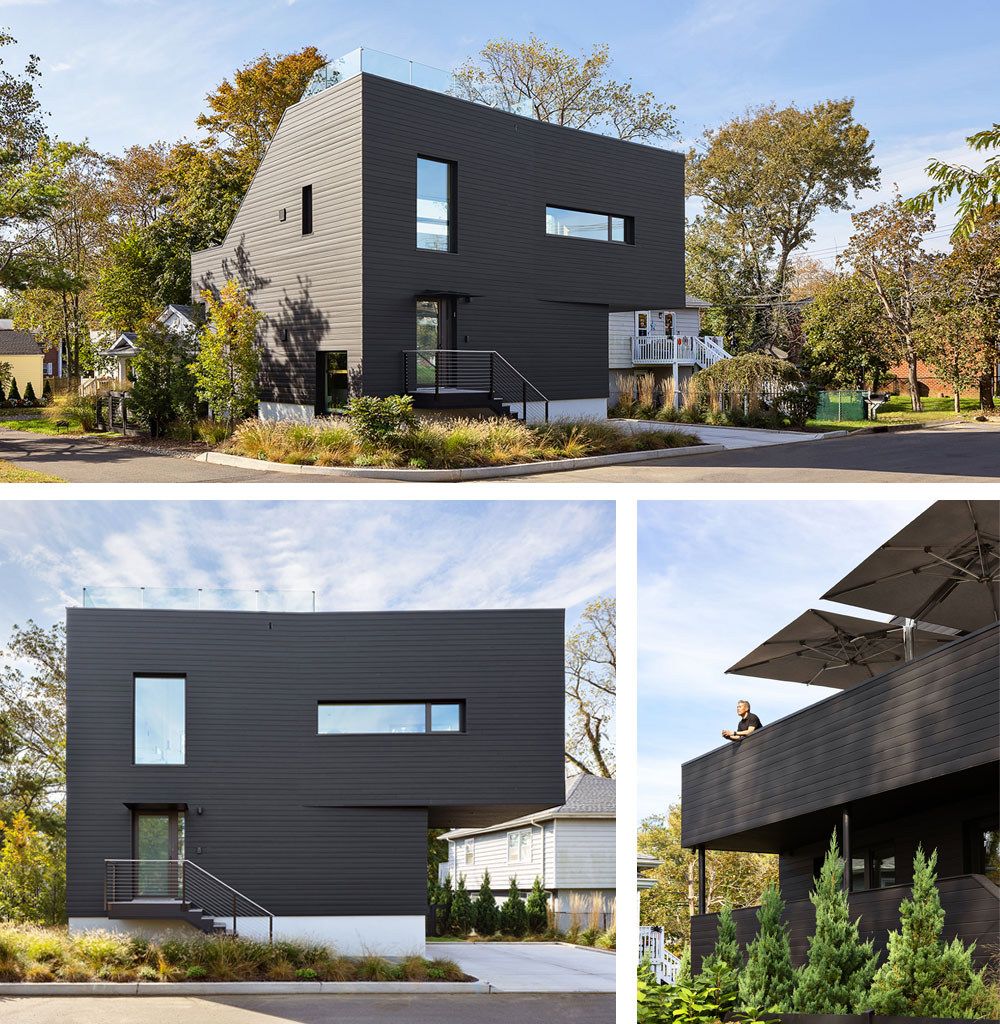
TOP | “The urban density and compact lot required us to build up rather than out,” designer and co-owner Joe Hom says. As for the black-stained cedar façade, “We knew from the start we wanted a black house,” in high-contrast to the light-filled interior. LEFT | Cantilevering the kitchen over the driveway conformed to zoning requirements, provided covered parking for one car and became a defining architectural feature of the house. RIGHT | Extensive terraces and decks maximize the home’s indoor/outdoor connection, says Hom, pictured here on the second-level terrace, which spans the length of the house. Doors off the first-floor covered porch provide direct access to the primary bedroom and office/guest room.
Yes, the 50-by-57-square-foot lot was small, but the couple saw only opportunity for its proximity to the beach (a 5-minute walk), Hanan’s family and nearby Main Street. “We lived in New York City for the past decade, and the location seemed ideal for city transplants,” says Hom, a designer and former technology executive. Besides, “Daniel always wanted a house by the beach, and I always wanted to build a high-performance home. It seemed like the best of both worlds.”
Hom and Hanan were determined to build a structure that would offer a model for sustainable, climate-smart living built to high-performance passive building standards. They retained Ryall Sheridan Architects of New York City, which specializes in Passive House design, because it is “as committed to building passive as we were,” Hom says. Project architects Will Robinette and Bernadette McCrann joined lead architect Ted Sheridan, all certified Passive House designers. All three have passed the arduous Passive House Examination administered by the Passive House Institute and have completed multiple Passive House projects, Sheridan notes.
The resulting 1,427-square-foot home, completed in 2021, “lives much larger than its actual size,” Hom says. “It just shows you that the size of the house doesn’t matter as much as the quality of the space and design.”
Design NJ: What is your definition of a Passive House?
Ted Sheridan: This is a design method that results in buildings that use only a small fraction of the energy that regular code-compliant buildings use. This requires special attention so the buildings are continuously insulated with no thermal bridges and no leaks. A constant supply of filtered fresh air is provided by the use of an Energy Recovery Ventilator (ERV) that brings in fresh air from outside in an energy-efficient manner. These are the quietest and most thermally comfortable buildings built today, and they require only small heating and cooling systems to maintain comfortable temperatures.
DNJ: How did the size of the lot influence the overall design?
Sheridan: The lot is minuscule. We called it our postage-stamp lot, but we still managed to fit three bedrooms, 2½ bathrooms and three decks into the design. It’s a stack, basically, with a high-ceiling basement and a second floor that cantilevers over the driveway. It really was designed to the inch to fit the zoning envelope that we had to work within.
DNJ: What were some of the main building requirements?
Joe Hom: We had very specific ideas of what we wanted: the house would be inverted in response to the dense neighborhood to maximize privacy, views and light, similar to the many beach houses in the coastal communities dotting the Fire Island National Seashore in Long Island, New York, where we’ve spent summers. For us, it was about the living space, our bedroom and the ability to host two other couples for long weekends. Ease of maintenance, building a strong indoor/outdoor connection and factoring in age-in-place features were among other prime considerations.
DNJ: What was the scope of your involvement in the design/build phase?
Hom: I worked closely with the architect to refine the overall layout and massing of the house, designed the kitchen layout and built-ins, and selected and procured all the finishes and fixtures. During construction, Daniel and I personally took over responsibility for air sealing the house. We drove down from our New York City apartment on weekends during the early days of Covid when everything was locked down and did the work ourselves. I was onsite most days, working directly with our builder and his trades.
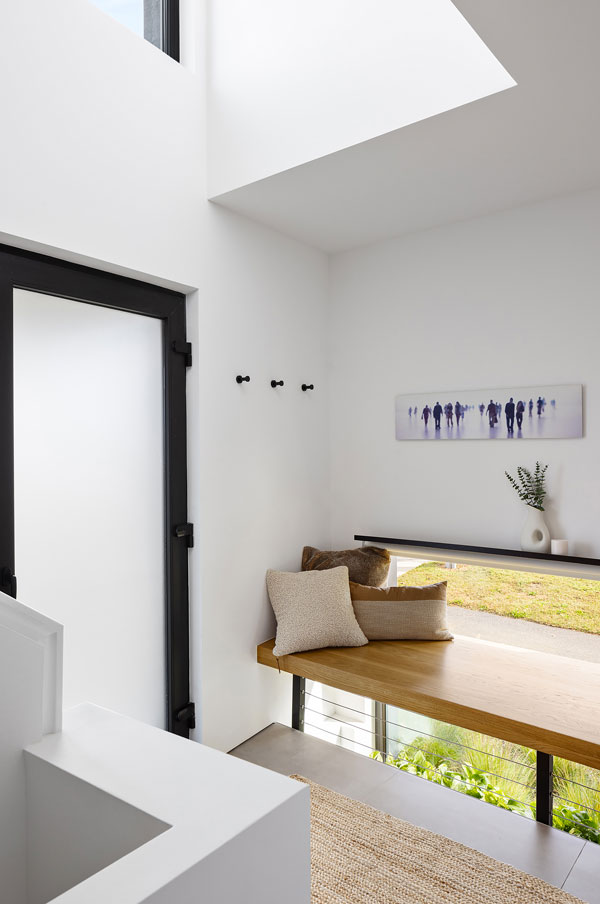
A floating white oak bench greets visitors in the foyer. The bench, cable railing and floating shelf are repeated design elements that help to connect the foyer to the outside landing.
DNJ: Describe the location of the public and private spaces.
Hom: The ground floor with its foyer houses Daniel’s office/guest room, the primary bedroom with an ensuite bath, a guest bath, an ERV closet, a laundry area and a covered porch. My studio is in the basement along with a gym and mechanical room. As you climb up the staircase to the second floor, the house is flooded with natural light from a wall of large south-facing windows, connecting the open-concept kitchen, dining and living space to the outdoor terrace for an expansive feeling.
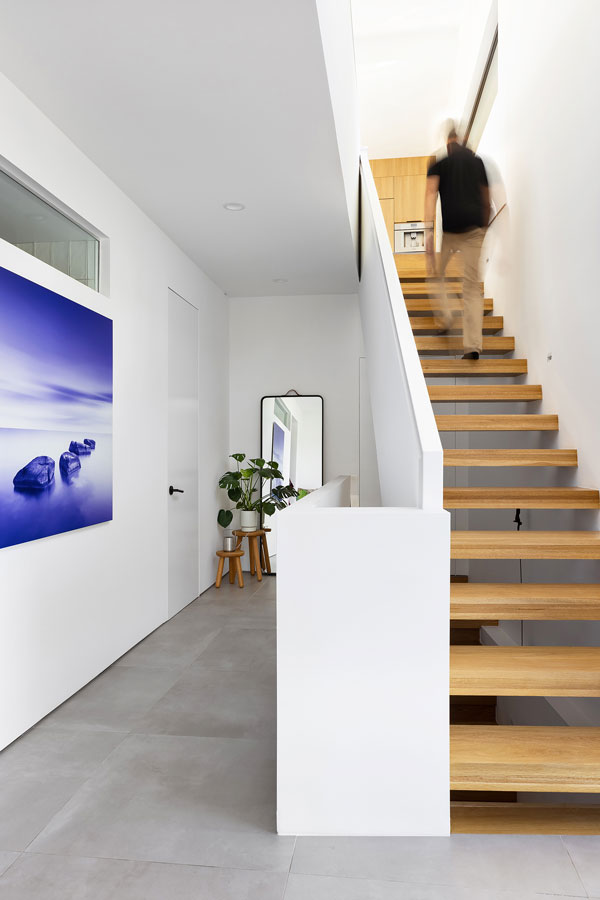
Double-height ceilings and an open-riser staircase “draw your attention away from the private rooms on the main floor and up to the living room on the second floor,” Hom says. Large-format porcelain tile flooring — used here and throughout — is easy to clean and maintain, he adds. Behind the transom window is a guest bathroom. The door at left leads to the primary suite.

A transom window brings natural light into an otherwise windowless guest bathroom. “The offset floating sink makes the bath feel more spacious while providing reasonable counterspace for toiletries,” Hom says. Textured and elongated white subway tile — installed in a vertical stack bond pattern — warms up the space — a modern interpretation on simple traditional subway tile.
DNJ: How does the foyer set the stage for the home’s general design aesthetic?
Hom: We wanted a casual but refined feeling. The experience starts with the floating front entry landing and its thin metal awning, which repeats and reinforces the main cantilevered architectural structure of the house. Upon entering the foyer, you are greeted by such features as a floating white oak bench, a floating metal shelf, textured throw pillows in brown tones and large-format concrete-look porcelain tile. The simple palette — and selection of materials — is repeated throughout the house to maintain a calm and tranquil feeling.
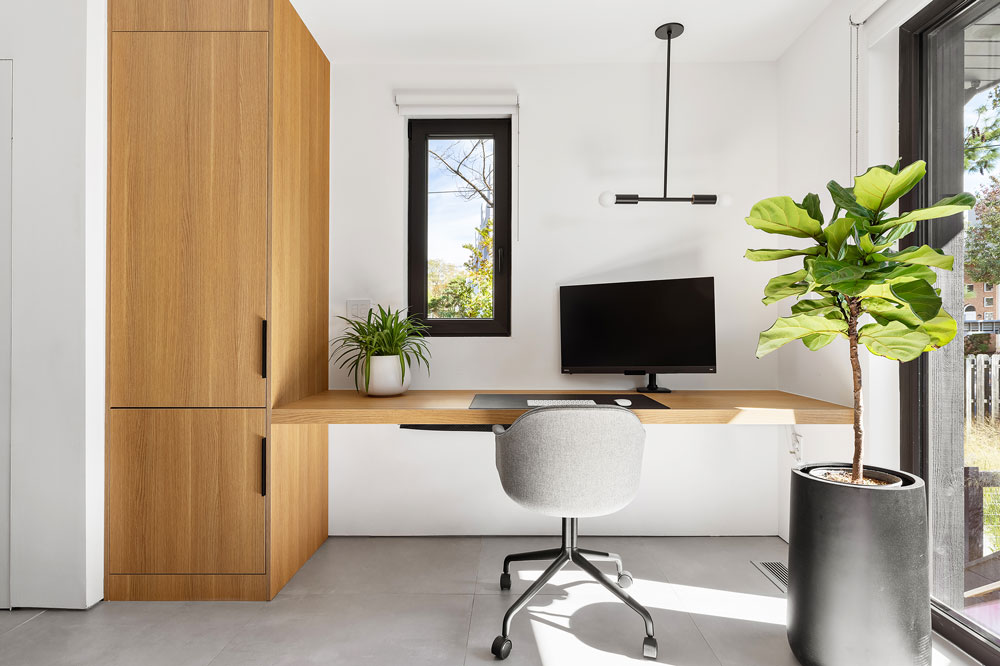
The office, which also doubles as a guest room, is within sight of the foyer. Opposite the desk is a wall of cabinetry (not shown) with a Murphy bed for overnight guests. “We keep the sliding door to the office open,” Hom says, “so that when you enter the house, you have a direct view to the floor-to-ceiling window framing the back porch.”
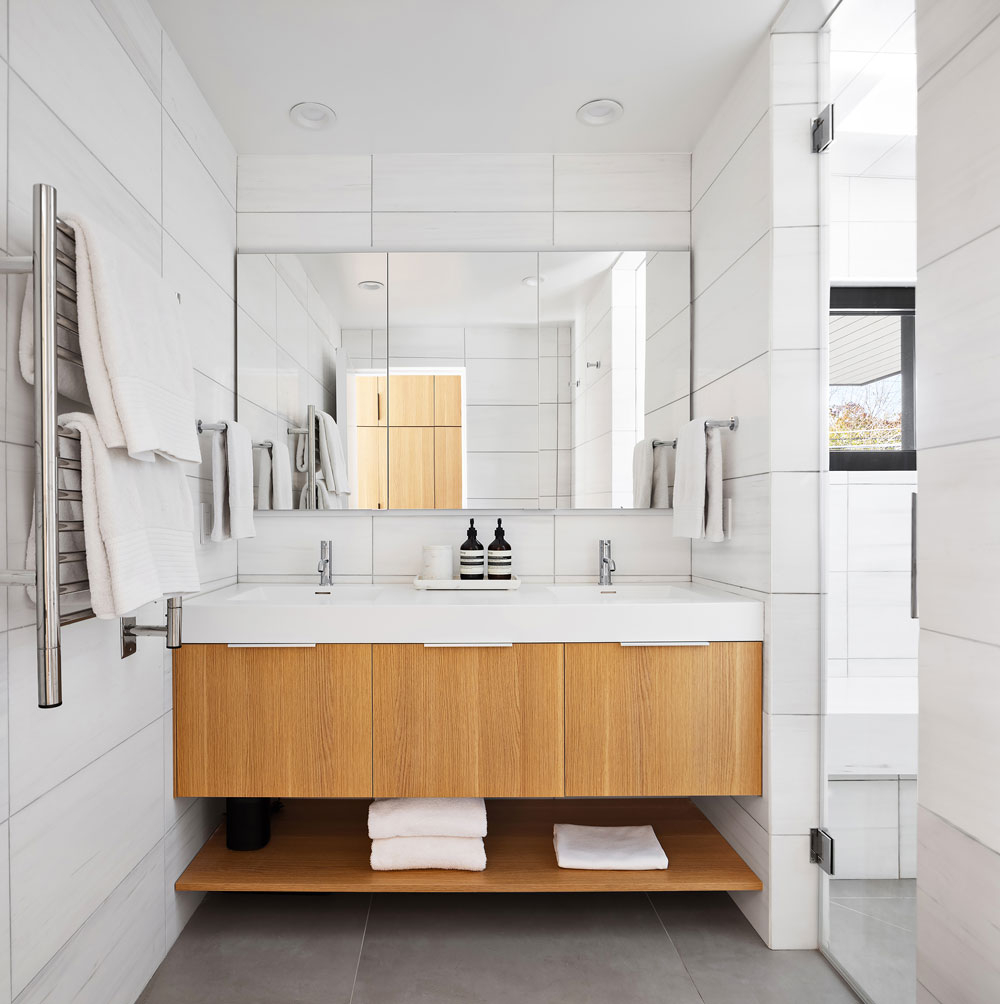
The primary bathroom’s custom oak vanity and clean minimalist palette echo the rest of the home’s cohesive design scheme. Age-in-place features such as a zero-threshold shower — here and in the guest bathroom — provide for easy access and safety.
DNJ: Describe how you established visual links elsewhere.
Hom: The kitchen cabinets, like all the millwork throughout the house, have a vertical-grain light oak finish. The cabinet doors and panels are actually made using a high-quality Italian textured laminate for easy cleaning and maintenance. Continuing with the theme of easy maintenance, we selected an easy-to-care-for quartz countertop and splurged on a matching slab backsplash to show off the beautiful veining. The living area, like the rest of the house, maintains a simple, calming color palette of light oak, gray and black.

Kitchen cabinets, made of high-quality Italian textured laminate for easy cleaning and maintenance, have a vertical-grain light oak finish. Quartz countertops are also fuss-free. A coordinating slab backsplash “shows off the beautiful veining,” Hom says. Simple black metal finger pulls and handles complement the black-framed windows and exterior siding.
DNJ: How did Passive House standards guide your appliance selections?
Hom: Besides selecting energy-efficient Energy Star® appliances in general, Passive House principles required us to select an induction cooktop and a recirculating hood vent. The building envelop of a Passive House is extremely airtight, preventing infiltration of outside air and loss of conditioned air. As such the air exchange in the house is controlled through a mechanical EVR system, so we don’t have exhaust vents for the kitchen, laundry or bathrooms like you would have in a traditional house. The house completely runs on electricity. There isn’t any gas in the house; we only have gas for the built-in barbecue grill on the terrace. Using an induction cooktop instead of a gas range eliminates harmful CO2 emissions in the house and eliminates the need for makeup air.
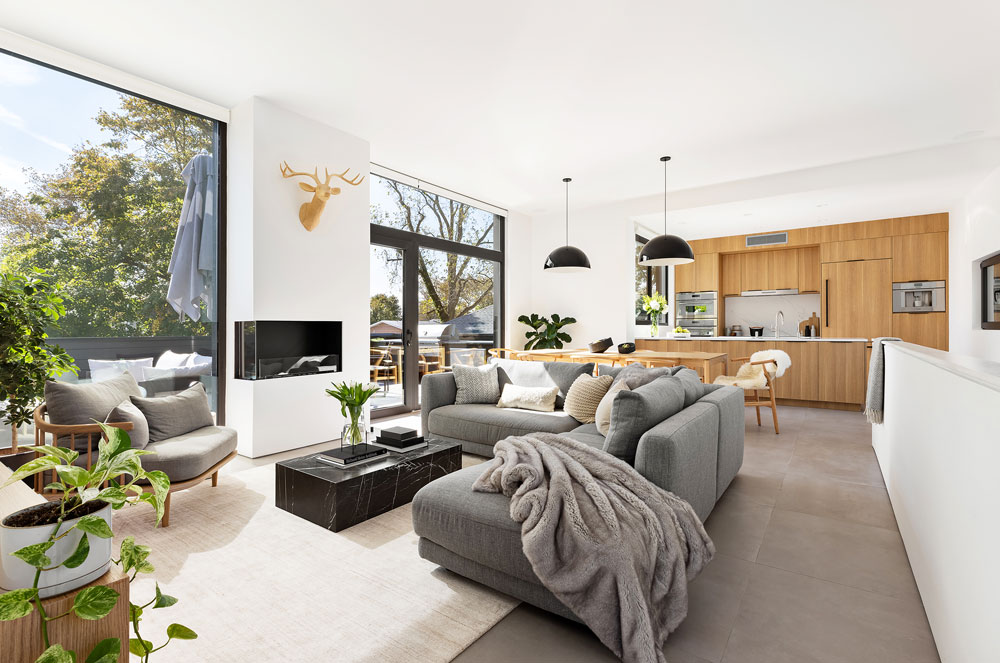
A wall of south-facing windows assures the open-concept living area is bathed in natural light throughout the day. “Being on the upper floor almost feels like you’re living in a tree house,” Hom says. Doors spill open to the outdoor terrace, which provides ample space for discreet dining, cooking and lounging. A fire table takes the chill out of cooler summer evenings and extends time spent outdoors.
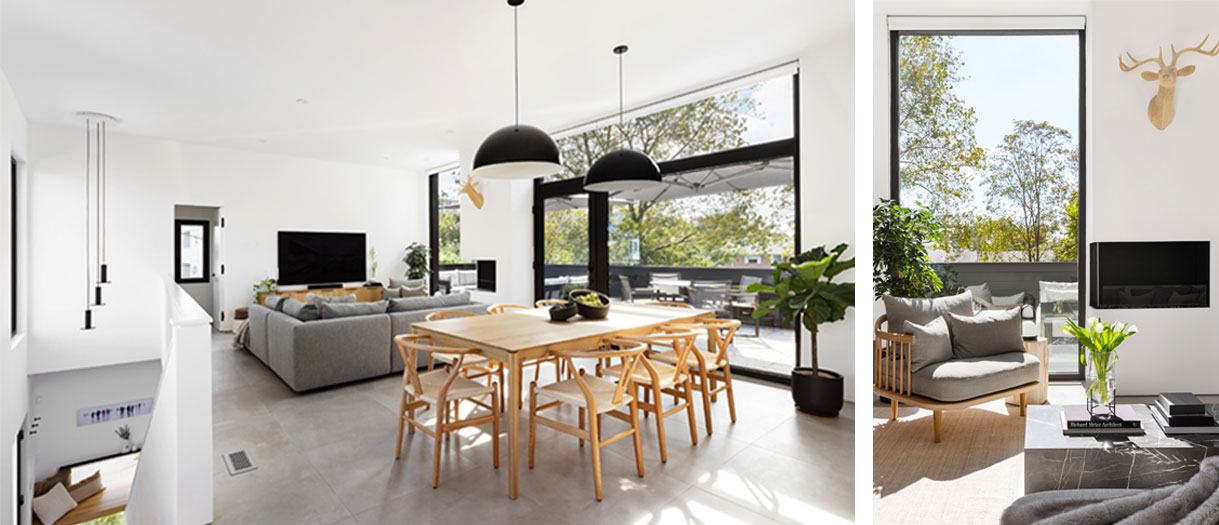
LEFT | The living area maintains a simple palette of light oak, gray and black. “Rich textures and materials keep the space feeling elegant but comfy and relaxed at the same time,” Hom says. RIGHT | A bioethanol fireplace works with Passive House requirements. “With a real fire, it has the look and feel of a regular fireplace,” Hom says. The wooden deer head — a nod to the deer that roam Long Branch and the surrounding area — “adds a touch of whimsy.”
DNJ: What are some other benefits and rewards of living in a Passive House?
Hom: The air quality and temperature of the house are noticeably better. Some houses struggle to stay warm when the temperature drops below zero, but our house remains pretty consistent and the heat isn’t on too much. Simply put, a comfortable home is a luxurious home, and we’re very fortunate to live here. It’s also rewarding to know we’re doing our part to help the environment and, hopefully, we’re able to show people that we can build a high-performance home that’s still beautiful and comfortable regardless of its size.

The third-level roof deck and terrace feature floating ipe tiles so the roofing could be easily serviced, if necessary, Hom says. A glass railing “minimizes the massing of the overall structure so the lines of the house aren’t visually affected,” he adds.
DNJ: What are some of the home’s unique attributes?
Sheridan: For a Passive House, we really managed to get the natural light balanced through the house. Some Passive House projects end up with an overwhelming amount of glass facing south and dark spaces on the north side, but this house has none of that. As you move around the house, you can always see out two or more windows. I also like the mysterious quality of the black exterior, which contrasts with the other houses nearby. The experience of the roof deck is great, like you’re floating above the entire neighborhood.
Hom: The wall of south-facing windows and easy access to the deck from the living room are my favorite features. Driving up to this black house you can’t imagine how bright and airy the open-concept living area could be and how it’s bathed in so much natural light throughout the day. Being on the upper floor almost feels like you’re living in a tree house.
DNJ: Do you find interest in passive home construction increasing?
Sheridan: We do, which is great for the environment and great for designers who have invested the time in learning the techniques of Passive House design. People are realizing the cost of energy is going to be a major economic factor in their future. Clients are coming to us because they realize that a Passive House with a modest solar photovoltaic panel system will give them a net-zero home that can also charge their electric car. We’re starting to design houses that are prepared to use clients’ electric car batteries as the backup battery for the house itself. So when the power goes out, the car keeps the house running, and when the sun shines, it fuels the car. We like the idea of a person’s house being a kind of working partner in their productive life, not just a container for occupancy.

